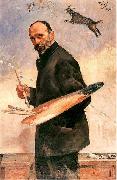Julian Falat El petróleo que Pinta la ReproducciónAll Julian Falat Oil PaintingsJulian Falat, (30 July 1853 in Tuliglowy near Lwow - 9 July 1929 in Bystra Sląska) was one of the most prolific Polish painters of watercolor and one of the country's foremost landscape painters as well as one of the leading Polish impressionists. Falat first studied under Wladysław Luszczkiewicz at the Krakow School of Fine Arts, and then at the Art Academy of Munich. After several trips throughout Europe and Asia in 1885, Fałat compiled a collection of studies from his voyages which would become useful later in the development of his artwork. Themes typical of Fałat's painting are Polish landscapes, hunting scenes, portraits, and studies from his voyages. In 1886, Falat accepted an invitation from future German Emperor Wilhelm II to serve as court painter in Berlin. Falat died in Bystra Sląska on July 9, 1929. A museum in Poland, called Falatowka, is devoted to him. Out of his three children, Kazimierz (Togo) (1904-1981) continued to paint in watercolour. |
|||

|
|||
|
|
|||
|
||||||||
| Julian Falat Julian Falat, (30 July 1853 in Tuliglowy near Lwow - 9 July 1929 in Bystra Sląska) was one of the most prolific Polish painters of watercolor and one of the country's foremost landscape painters as well as one of the leading Polish impressionists. Falat first studied under Wladysław Luszczkiewicz at the Krakow School of Fine Arts, and then at the Art Academy of Munich. After several trips throughout Europe and Asia in 1885, Fałat compiled a collection of studies from his voyages which would become useful later in the development of his artwork. Themes typical of Fałat's painting are Polish landscapes, hunting scenes, portraits, and studies from his voyages. In 1886, Falat accepted an invitation from future German Emperor Wilhelm II to serve as court painter in Berlin. Falat died in Bystra Sląska on July 9, 1929. A museum in Poland, called Falatowka, is devoted to him. Out of his three children, Kazimierz (Togo) (1904-1981) continued to paint in watercolour. |
||||||||
|
|
||||||||
| Pintura identificación:: 74576 Hunters' rest in forest 1889;. oil on canvas, 58 x 119 cm. cjr |
||||||||
|
|
||||||||
| Pintura identificación:: 74590 Elk oil on canvas, 96 x 192 cm. 1899 cjr |
||||||||
|
|
||||||||
| Pintura identificación:: 74591 Self-portrait from palette Oil on canvas, 135,5 x 86 cm. 1896 cjr |
||||||||
|
|
||||||||
| Pintura identificación:: 86037 Self-portrait. Date 1903 Medium Oil on canvas Dimensions 47.5 x 132.5 cm (18.7 x 52.2 in) cjr |
||||||||
|
|
||||||||
| Pintura identificación:: 97878 Self portrait 1903 Medium oil on canvas Dimensions 47.5 x 132.5 cm cyf |
||||||||
|
|
||||||||
| ARTISTA PREVIO PROXIMO ARTISTA | ||||||||
|
|
||||||||
|
Julian Falat Julian Falat, (30 July 1853 in Tuliglowy near Lwow - 9 July 1929 in Bystra Sląska) was one of the most prolific Polish painters of watercolor and one of the country's foremost landscape painters as well as one of the leading Polish impressionists. Falat first studied under Wladysław Luszczkiewicz at the Krakow School of Fine Arts, and then at the Art Academy of Munich. After several trips throughout Europe and Asia in 1885, Fałat compiled a collection of studies from his voyages which would become useful later in the development of his artwork. Themes typical of Fałat's painting are Polish landscapes, hunting scenes, portraits, and studies from his voyages. In 1886, Falat accepted an invitation from future German Emperor Wilhelm II to serve as court painter in Berlin. Falat died in Bystra Sląska on July 9, 1929. A museum in Poland, called Falatowka, is devoted to him. Out of his three children, Kazimierz (Togo) (1904-1981) continued to paint in watercolour. |
||||||||
|
|
||||||||
|
CONTACTE EEUU |










